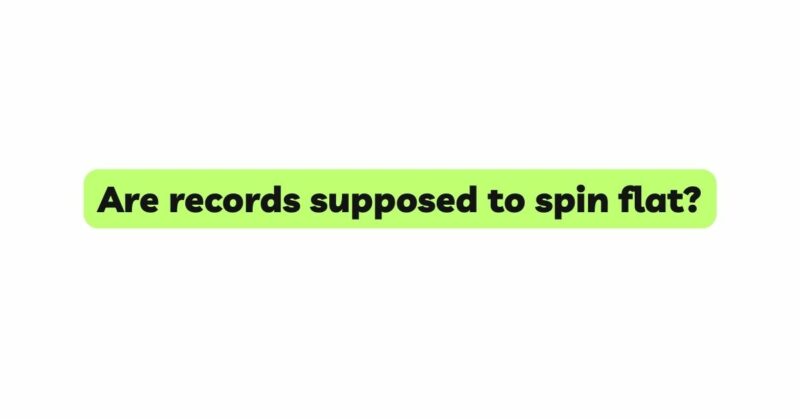In the realm of vinyl records and turntables, an intriguing question often arises: Are records supposed to spin flat? The debate surrounding the proper orientation of vinyl records during playback has sparked curiosity and confusion among audiophiles and music enthusiasts. Traditionally, records have been played flat on turntables, but alternative methods, such as vertical turntables and wall-mounted setups, have challenged this conventional practice. In this article, we will explore the various perspectives surrounding record orientation, the impact on audio quality, and the validity of non-flat record playback methods. By shedding light on this contentious topic, we hope to provide clarity and understanding to music enthusiasts seeking the best possible listening experience.
- The Tradition of Flat Record Playback:
Throughout the history of vinyl records, the conventional method of playback has been to place them flat on turntables. The record sits horizontally on the turntable platter, and the stylus (needle) follows the grooves as the record rotates clockwise or counterclockwise. This standard orientation has been widely accepted and practiced, resulting in countless hours of enjoyable music listening experiences.
Advantages of Flat Record Playback: a. Stability: Flat playback ensures that the record maintains a stable and consistent contact with the turntable platter, minimizing vibrations and potential distortions. b. Needle Alignment: A flat record allows the needle to maintain a steady, accurate alignment with the grooves, optimizing sound quality and reducing wear on both the record and stylus. c. Standard Equipment: Turntables and record players are designed with flat record playback in mind, making it the most widely supported method.
- The Rise of Alternative Playback Methods:
a. Vertical Turntables: Vertical turntables have gained popularity as a unique and visually striking way to play records. In this setup, the record is mounted vertically on a wall or stand, and the stylus tracks the grooves as the record spins vertically.
Advantages of Vertical Turntables: i. Space-Saving: Vertical turntables are ideal for small spaces or wall-mounted installations, making them a stylish and compact choice for audiophiles with limited room. ii. Aesthetics: The striking visual appeal of a vertically spinning record is an attractive feature for modern interior design and showcases vinyl collections as artistic displays.
b. Wall-Mounted Turntables: Wall-mounted turntables are a variation of vertical turntables, where the entire turntable mechanism is attached to a wall, and the record spins vertically.
Advantages of Wall-Mounted Turntables: i. Space Efficiency: Wall-mounted turntables save valuable floor space and can be conveniently placed at eye level for easy access and viewing. ii. Conversation Piece: Wall-mounted turntables become conversation starters and focal points within a room, elevating the aesthetic value of the vinyl record collection.
- Addressing the Impact on Audio Quality:
One of the primary concerns among audiophiles considering non-flat playback methods is the potential impact on audio quality. Critics argue that deviations from flat playback may introduce unwanted mechanical stress on the record and affect the stylus’ ability to accurately track the grooves. Additionally, issues such as increased surface noise, record wear, and potential sonic distortions have been raised as potential drawbacks.
However, proponents of alternative playback methods argue that advancements in turntable technology and stylus design have mitigated these concerns. They maintain that with proper setup and calibration, vertical and wall-mounted turntables can deliver an enjoyable listening experience with minimal compromises in audio quality.
- The Role of Turntable Adjustments:
Proper calibration and setup are vital for achieving satisfactory audio quality, regardless of the orientation of the record. Turntables must be correctly aligned, and tracking force and anti-skate adjustments need to be carefully configured for optimal performance. Properly calibrated turntables can minimize the potential negative effects associated with non-flat playback.
- Individual Preferences and Aesthetics:
Ultimately, the choice between flat and non-flat record playback methods boils down to individual preferences and aesthetic considerations. Some listeners prioritize audio fidelity and prefer the traditional, flat playback method, while others value aesthetics and unique setups, favoring vertical or wall-mounted turntables.
Conclusion:
The debate over whether records are supposed to spin flat has ignited discussions within the vinyl enthusiast community. While flat record playback remains the conventional and widely supported method, alternative playback approaches, such as vertical and wall-mounted turntables, have garnered attention for their unique aesthetics and space-saving attributes.
As technology advances and turntable design evolves, the concerns related to non-flat playback, such as potential audio quality compromises, are gradually being addressed. Proper setup and calibration of turntables play a crucial role in ensuring satisfactory audio performance, regardless of the orientation of the record.
Ultimately, the choice of record playback method should be guided by individual preferences, space constraints, and the desire for a unique and visually appealing vinyl listening experience. Whether one chooses the traditional flat playback or ventures into the realm of alternative setups, the magic of vinyl records and the joy of music appreciation remain constant, enhancing the timeless pleasure of vinyl listening for all audiophiles.


